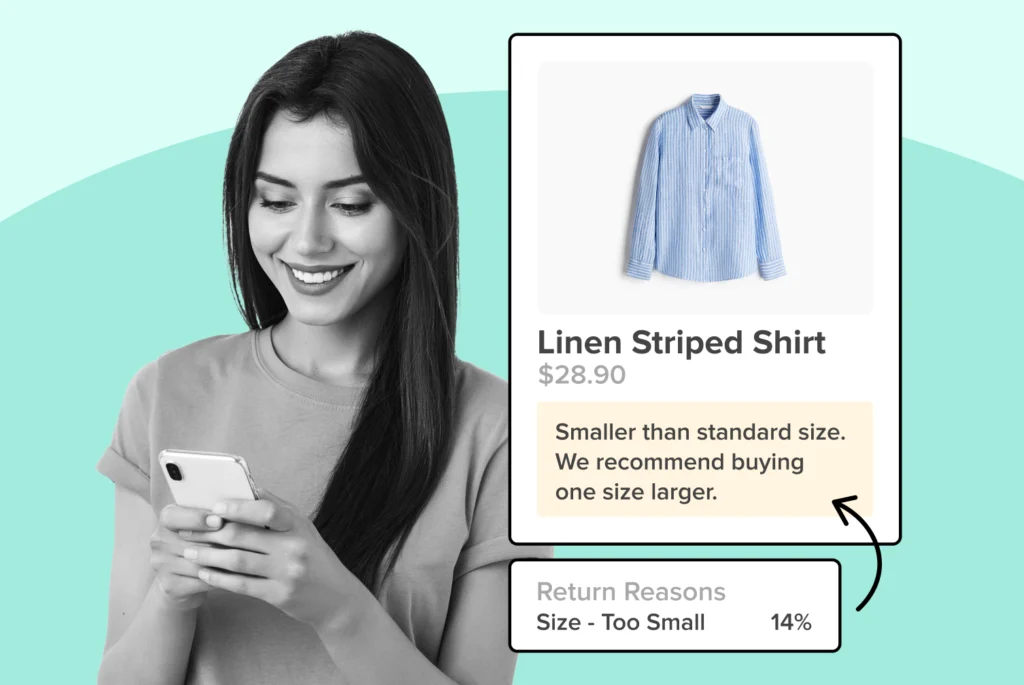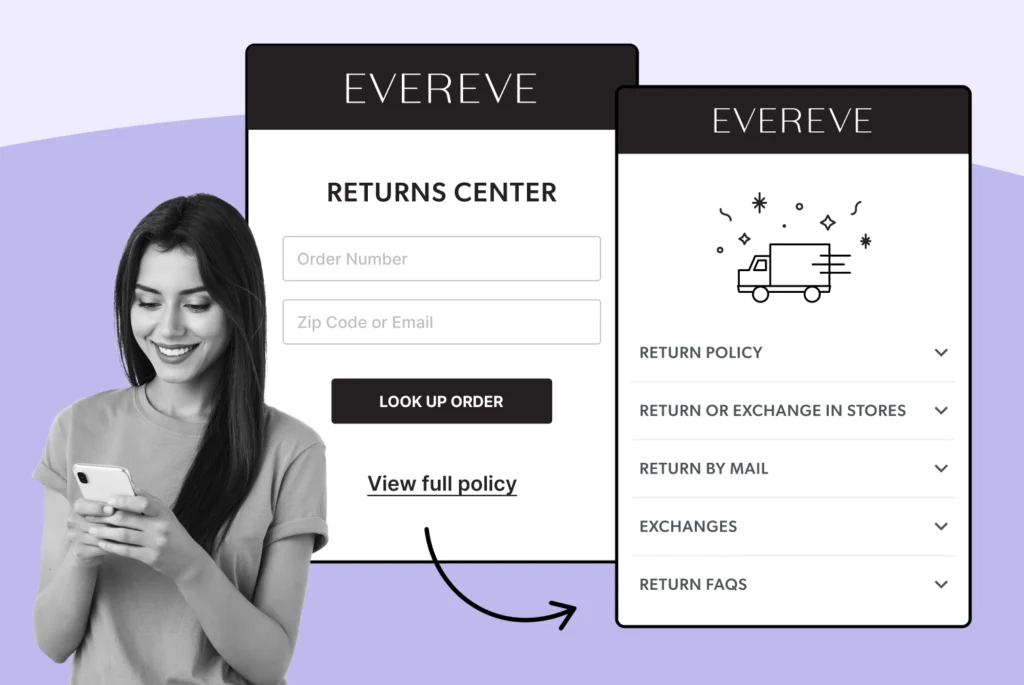
6 Reasons to Avoid Shopify Returns Labels in the Box
Discover why including Shopify returns labels in the box can be a costly mistake. Six compelling reasons to reconsider this practice!
Shipping, Tracking & Notifications
Boost customer experience and reduce support tickets
Realtime order and shipment tracking
Proactive order and shipping notifications
AI-Enhanced Discounted Labels
Predictive pre-purchase estimated delivery dates
Self-Serivce branded order tracking
Effortless experience delivered
Identify and Resolve Order Issues
Realtime order and shipment tracking
Make returns profitable and delight customers
Flexibility to define any return destinations & conditions
Simplify returns for your customers and team
Incentivize exchanges over returns
Returns management made easy for your team
Returns management made easy for your team
Easy claims and smart upsells
Understand why your customers are returning
In-Store & Curbside Pickup
Unify the online and the in-store experience
Hassle-free pickup experience for customers
In-Store dashboard to keep operations streamlined
In-Store and Online orders unified
Drive foot-traffic to your stores
Shipping, Tracking & Notifications
Boost customer experience and reduce support tickets
Realtime order and shipment tracking
Proactive order and shipping notifications
AI-Enhanced Discounted Labels
Predictive pre-purchase estimated delivery dates
Self-Serivce branded order tracking
Effortless experience delivered
Identify and Resolve Order Issues
Realtime order and shipment tracking
Make returns profitable and delight customers
Flexibility to define any return destinations & conditions
Simplify returns for your customers and team
Incentivize exchanges over returns
Returns management made easy for your team
Returns management made easy for your team
Understand why your customers are returning
In-Store & Curbside Pickup
Unify the online and the in-store experience
Hassle-free pickup experience for customers
In-Store Dashboard to keep operations streamlined
In-Store and Online orders unified
Drive foot-traffic to your stores
Boost customer experience and reduce support tickets
Realtime order and shipment tracking
Proactive order and shipping notifications
AI-Enhanced Discounted Labels
Predictive pre-purchase estimated delivery dates
Self-Serivce branded order tracking
Effortless experience delivered
Make returns profitable and delight customers
Flexibility to define any return destinations & conditions
Simplify returns for your customers and team
Incentivize exchanges over returns
Returns management made easy for your team
Equip your team for precise return checks.
Understand why your customers are returning
Unify the online and the in-store experience
Hassle-free pickup experience for customers
In-Store Dashboard to keep operations streamlined
In-Store and Online orders unified
Drive foot-traffic to your stores
Find the answer to all your questions
Take a step by step trip through our functionality to see how we can improve your ecommerce processes.
Explore the most comon questions about WeSupply
Calculate the ROI that WeSupply can bring you
Request a no strings attached review of your current shopping experience and missed conversion opportunities
Read actionable articles on how to optimize your post-purchase experience and decrease support tickets
Get inspired by stories of how our customers implemented an effortless post-purchase experience
Wondering if WeSupply is a good fit for you? Read through our use cases to see how we can help you increase conversion & improve CX!
A Deep Dive into Top Companies' Order Tracking & Returns Strategy
Find the answer to all your questions
Explore the most comon questions about WeSupply
Calculate the ROI that WeSupply can bring you
Request a no strings attached review of your current shopping experience and missed conversion opportunities
Take a step by step trip through our functionality to see how we can improve your ecommerce processes.
Read actionable articles on how to optimize your post-purchase experience and decrease support tickets
Get inspired by stories of how our customers implemented an effortless post-purchase experience
A Deep Dive into Top Companies' Order Tracking & Returns Strategy
Wondering if WeSupply is a good fit for you? Read through our use cases to see how we can help you increase conversion & improve CX!

In the fast-paced world of eCommerce, return and refund policies are a vital touchpoint in shaping the customer experience and influencing purchase decisions. For Shopify merchants, the return policy is not just a legal or logistical requirement—it’s a strategic lever. A nuanced question many store owners face is whether to require comments during the return process. While it might seem like a small detail, this decision can significantly affect customer satisfaction, product development, and operational efficiency.
This comprehensive guide explores the pros and cons of requiring comments in Shopify return policies and offers practical insights into how to create a customer-centric return policy that balances feedback collection with frictionless returns.
Return policies serve multiple functions in an online store. They manage customer expectations, reduce potential disputes, and offer a sense of security that encourages buyers to take the plunge. Clear and transparent return policies are particularly important in eCommerce, where customers don’t have the benefit of physically inspecting products before purchase.
When return policies are clear, concise, and aligned with shopper expectations, they can actually drive sales and build trust. According to recent data, a generous and transparent return policy can increase customer satisfaction and loyalty. Using concise language in return policies helps enhance customer understanding by avoiding legal jargon and being transparent about the policy details. On the flip side, vague or restrictive return policies can lead to cart abandonment and poor reviews.
Before diving into the debate over requiring comments, it’s important to understand the core components of a solid return policy. At a minimum, your Shopify return policy should clearly outline:
Return window: How many days does the customer have to initiate a return?
Item condition: Does the item need to be unused, with tags, or in original packaging?
Refund type and process: Will the customer receive a refund, store credit, or exchange? Ensure the refund process is clear and simple to enhance customer trust.
Shipping costs: Who covers return shipping—the customer or the store?
Simplicity and accessibility are key. Customers shouldn’t have to dig through paragraphs of legal jargon to figure out how to return a product. Your return policy should be posted prominently on your website and in post-purchase emails.
Today’s online shoppers expect more than just a product—they expect an experience. A seamless and generous return process plays a big role in building that experience. To enhance customer satisfaction and streamline operational processes, it is crucial to manage returns effectively. In most countries, shoppers have legal rights to return unsatisfactory products, but the best Shopify merchants go beyond legal requirements to meet (and exceed) customer expectations.
To meet these expectations, return policies must be:
Customer-friendly: Clearly communicated, fair, and easy to execute.
Aligned with your brand voice: Friendly and reassuring language goes a long way.
Flexible: Offering options like exchanges, refunds, and store credit helps accommodate different customer needs.
Now that we’ve established what a good return policy looks like, let’s revisit the key question: Should you require comments from customers when they initiate a return to enhance customer trust?
First and foremost, it’s essential to understand that requiring comments is optional—there is no legal obligation to ask customers for the reason behind their return. Most Shopify policy templates and industry-standard documents, including Shopify’s own Refund Policy Generator and TermsFeed templates, do not mention mandatory customer comments.
Many successful Shopify stores, such as FiftyThree, Calm the Ham, and Greats, do not require comments in their return policies. They focus on minimizing friction and maximizing ease, allowing customers to complete the process quickly without additional hurdles. This shows that while collecting feedback can be valuable, it’s not a prerequisite for success in the eCommerce world.
That said, there are compelling benefits to requiring comments, particularly for data-driven brands looking to refine their product offerings, improve customer satisfaction, and improve customer experience.
One of the biggest advantages of requiring comments is the ability to collect detailed feedback. Customers often return items due to issues with sizing, material quality, or unmet expectations—and comments can uncover these reasons. For instance, feedback like “the fabric feels rough” or “the sizing runs small” can help product teams make necessary improvements.
If you see recurring themes in return comments, such as complaints about a specific SKU, you can take proactive action—whether that means updating your product description, adjusting sizing guides, or discontinuing problematic items altogether.
Sometimes, customers express both frustration and loyalty in the same message. A comment like “Your clothes are amazing – quality excellent, and I own several pieces. I will try again” gives you a golden opportunity to retain the customer with a discount or personalized message.
Combat inconvenience with proactivity & self service
Book a quick call with our experts to see how WeSupply can help you make returns easy for your customers with a beautiful, self-service solution that makes their experience easier while also providing new ways to lower costs and earn back revenue.
Highly engaged shoppers often leave longer, more thoughtful comments. These customers are often worth the effort to win back through follow-up offers, early access to new products, or store credit incentives.
Even when customers are unhappy, giving them a chance to voice their experience can make them feel acknowledged. That emotional validation may help preserve your brand reputation and maintain long-term loyalty.
Despite the benefits, requiring comments also introduces several potential downsides, particularly if not implemented thoughtfully. One significant issue is the potential to create unsatisfied customers if their feedback is not addressed properly.
Asking for a comment adds another step to the return journey. For customers who are already disappointed, this can be the straw that breaks the camel’s back. Any extra friction could reduce satisfaction or lead to cart abandonment in future purchases.
While it may seem like fewer returns are a good thing, discouraging legitimate returns can hurt your brand. Customers may feel tricked or frustrated if they perceive the process as intentionally difficult, which could lead to negative reviews or chargebacks.
Not all comments are constructive. Some might be emotionally charged or outright hostile, like “It’s quite possibly the ugliest color I’ve ever seen.” These comments are difficult to act on and may demoralize your team if not handled carefully.
If you’re going to collect feedback, you need a system to manage it. Without proper tools or workflows in place, analyzing comment data can become overwhelming and may yield limited actionable insights.
Whether or not to require comments ultimately depends on your brand’s resources, values, and goals. For online sellers, creating effective return policies is crucial. Here’s how to decide:
If your goal is frictionless returns, skip the comments. Focus on building a quick, intuitive return process that boosts trust and repeat purchases.
If your goal is feedback-driven improvement, ask for comments—just make sure you have a process in place to analyze and act on the data.
For a middle-ground solution, consider making comments optional but encouraged, using phrasing like: “We’d love to know why you’re returning this item—your feedback helps us improve.”
Beyond the comments debate, Shopify merchants must ensure their return policy is robust, effective, and includes a transparent refund policy. Here’s how to do it:
Include key components such as return windows, refund types, item condition requirements, and who pays for shipping. The fewer surprises your customers face, the better.
Offering exchanges instead of refunds can help reduce revenue loss while still meeting customer needs. Be clear about how and when exchanges can be initiated by defining a comprehensive exchange policy.
Store credit is a strategic alternative to full refunds. It keeps revenue within your ecosystem and encourages repeat purchases, especially from customers who might just want a different size or color.
Who covers the return shipping—your business or the customer? Make this crystal clear, and consider offering prepaid return labels to boost satisfaction. Additionally, it’s important to address how shipping fees impact the profitability of your return policies.
Concise language is crucial. Make your return policy easy to read, understand, and find on your site. Use headers, bullets, and FAQs to improve clarity.
Return trends and customer expectations evolve. Regularly revisit and update your policy based on returns data, feedback, industry benchmarks, and business goals.
Looking at shopify return policy examples from other Shopify merchants can offer inspiration and clarity. Stores like FiftyThree, Calm the Ham, and Greats have built success without requiring return comments, focusing instead on simplicity and ease.
Meanwhile, other brands have integrated optional feedback fields in their returns portal, using tools like WeSupply or Loop Returns to automate the data collection and analysis process.
Crafting a balanced return policy that aligns with your business goals and enhances the customer experience can be challenging, especially when deciding whether to require comments during the return process. WeSupply makes it easier for Shopify merchants by providing tools that streamline returns and offer valuable insights—without adding friction to the customer journey.
Key Features of WeSupply:
Actionable Insights: Collect and analyze return data to identify trends and areas for improvement.
Prepaid Return Labels: Enhance customer convenience and satisfaction.
Seamless Integration: Works flawlessly with Shopify to enhance the post-purchase experience.
Analytics Dashboard: Monitor return reasons and customer feedback in real-time to drive data-driven improvements.
Personalized Communications: Keep customers informed with automated notifications and updates.
Offer Instant Credit to Encourage Exchanges: Incentivize exchanges over refunds, lowering your average eCommerce return rate while boosting sales through instant store credit.
Create Flexible Return Rules to Match Any Use Case: Avoid restrictive policies by creating smart return rules tailored to item attributes, including free return shipping conditions and intelligent dispositions for efficient sorting.
With WeSupply, you can implement a customer-friendly return policy that strikes the perfect balance between collecting valuable feedback and maintaining a hassle-free return experience. Whether you choose to require comments or keep the process straightforward, WeSupply gives you the flexibility and tools to optimize returns and build lasting customer relationships. Ready to see how WeSupply can transform your return process? Book a demo today!
Simplify Returns for Your Customers and Support Team
Book a quick call with our experts to see how WeSupply can help you: simplify the Return experience with just a few clicks, reduce customer service calls and manual processing, notify your customer about their refund, automate returns and reduce user error.
In the end, there’s no one-size-fits-all answer. Requiring comments during the return process is not a legal necessity, nor is it a universal best practice—but it can be a valuable strategic tool if used wisely.
✅ Choose to require comments if you have the resources to analyze feedback and are committed to improving your product or service based on that data.
✅ Skip the requirement if your focus is on ease of use, high conversion rates, and streamlined customer service.
Whichever path you choose, remember that the ultimate goal of your return policy is to support a great customer experience, reinforce trust, and protect your brand. A well-implemented return policy is crucial for maintaining your business’s overall reputation. By balancing transparency, flexibility, and operational efficiency, your Shopify store can turn returns from a cost center into a customer loyalty engine.
Requiring comments in your Shopify return policy is entirely optional, but it can offer strategic benefits depending on your business goals. While not legally mandated or universally practiced, collecting customer feedback during returns can help identify trends, enhance product development, and re-engage loyal buyers. However, it may also add friction, potentially discouraging legitimate returns or frustrating customers.
With WeSupply, you can strike the right balance between feedback collection and a seamless return process. Our customizable return portals, instant credit options, and flexible return rules make it easy to optimize your policy without compromising customer satisfaction. Plus, actionable insights and automated workflows help you stay ahead of trends and streamline operations.
Ultimately, the choice to require comments should reflect your brand’s focus—whether it’s effortless returns or data-driven improvements. WeSupply makes it simple to achieve both.
Ready to optimize your return policy? Get started with WeSupply today!
No, it is not legally required to ask customers for comments when processing returns. Unlike more complex legal documents, such as disclaimers or terms and conditions pages, many successful Shopify stores do not require return reasons and instead focus on streamlining the process for customer convenience.
Collecting return comments can enhance customer confidence by providing insights into why products are being returned, identifying recurring issues, and helping improve product offerings. It can also help customer service teams personalize responses and potentially recover at-risk customers.
It can. Requiring comments adds friction to the return process and may lead to customer frustration or discourage legitimate returns. Clearly displaying the return policy can save time by preventing disputes and minimizing back-and-forth communication with frustrated customers. For brands focused on simplicity and satisfaction, offering comments as optional is often the better approach.
Yes! WeSupply offers the flexibility to make comments optional during the return process, allowing customers to share their thoughts if they wish—without feeling pressured. Additionally, features like automated workflows, instant credit options, and smart return rules ensure a streamlined process that minimizes friction, whether you choose to collect feedback or not.
WeSupply’s analytics dashboard consolidates all customer feedback collected through return comments, giving you clear, actionable insights. You can easily identify common reasons for returns, spot patterns, and make data-driven improvements to your products and processes. Plus, automated reporting ensures you always stay updated without the need for manual data entry.
Yes. WeSupply has an Official Shopify App. You can download it and start integrating with your Shopify Store.
Yes, WeSupply has an official extension for Magento. The WeSupply x Magento integration allows for automating order tracking experiences, reducing customer inquiries, automating shipping email and SMS notifications, and providing a fully branded order tracking experience
Yes, WeSupply has an official BigCommerce App. You can integrate WeSupply with your BigCommerce store to improve your post-purchase customer experience.
Learn How To Create Successful Post Purchase Email Campaigns
Build an effective post-purchase email flow that helps you increase customer satisfaction and drive revenue growth!

Discover why including Shopify returns labels in the box can be a costly mistake. Six compelling reasons to reconsider this practice!

Learn how to optimize packaging for hassle-free returns and exchanges. Enhance customer satisfaction and streamline your process. Read the guide now!

Learn effective communication strategies to improve sizing accuracy and reduce returns. Discover practical tips to enhance your online shopping experience.

Explore the legal aspects of return policies and whether they constitute a legal agreement. Learn how this impacts your shopping experience. Read more.

Discover 5 effective strategies to enhance your product photos and minimize returns. Improve customer satisfaction and boost sales—read the article now!

Learn how to optimize packaging for hassle-free returns and exchanges. Enhance customer satisfaction and streamline your process. Read the guide now!

Discover effective strategies to reduce shipping delays and enhance your logistics. Improve efficiency and keep your operations running smoothly. Read more!

Discover the key traits that define today’s influencers and how they shape marketing strategies. Enhance your influencer approach!

Learn effective post-purchase email strategies to enhance customer loyalty and improve retention. Engage your customers today!